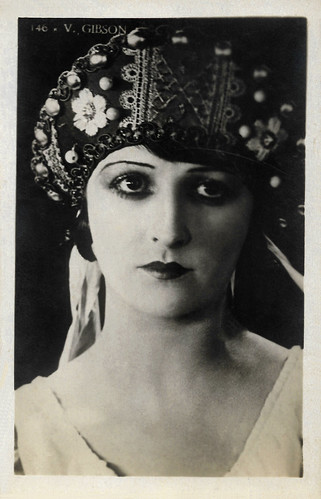Portuguese collector's card by Socieda Industrial dos Tabacos de Angola, Ltd. (Sital). Photo: Lux Film.

Italian postcard by Fotocelere, no. 146.

German postcard by Westi Film sent to Royal Ciné, Uzès, France, 18-2-1925. Vivian Gibson in Niniche (Victor Janson, 1925), starring Ossi Oswalda.

German postcard by Verlag Hermann Leiser, Berlin-Wilm., no. 6407. Photo: Hegewald-Film. Vivian Gibson in Der Orlow/The Diamond of the Czar (Jacob Fleck, Luise Fleck, 1927).

French postcard. Photo: Ciné Paris, no. 241. Vivian Gibson and Ivan Petrovitch in Der Orlow (Jakob & Luise Fleck, 1927). Gibson plays the revue star Nadja Nadjakowskaja, Petrovitch the pilot Alexander.

German postcard. Publicity for the screening at the Berlin cinema UFA Palast am Zoo of Regine - die Tragödie einer Frau/Two Women (Erich Waschneck, 1927), starring Lee Parry and Vivian Gibson, and produced by National-Film.
Birthplace
Vivian Gibson was born Lavinia Seraphine Gibson in Liverpool, England in 1893. (According to Wikipedia, but according to IMDb she was born in 1898; Thomas Staedeli (Cyranos) mentions 1895 as her birth year).
She had dancing classes in London, and as a child, she already did stage appearances.
In 1916, she made her film debut in the British film Odd Charges (Frank Miller, 1916) with Frank Stanmore and James Reardon. She also appeared with Stanmore and Reardon in The Persecution of Bob Pretty (Frank Miller, 1916).
Gibson later also appeared in British films like Barbara Elopes (Fred Paul, Jack Raymond, 1921), Demos/Why Men Forget (Denison Clift, 1921) with Warwick Ward, and Tense Moments from Opera (Challis Sanderson, a.o., 1922) with Clive Brook.
In 1922 German showbusiness impresario Rudolf Nelson contracted Vivian Gibson for the German theatre. She moved to Europe's cultural centre at the time, Berlin.

German postcard by Ross Verlag, no. 1827/1, 1927-1928. Photo: Lindner.

German postcard by Ross Verlag, no. 3347/1, 1928-1929. Photo: Orplid-Maestro Film. Vivian Gibson in Angst - Die schwache Stunde einer Frau/Fear (Hans Steinhoff 1928).
German postcard by Ross Verlag, no. 3597/1, 1928-1929, sent by mail in Belgium in 1929. Photo: Aafa Film.

German postcard by Ross Verlag, no. 3850/1, 1928-1929. Photo: Aafa Film. In the Aafa film Der Unüberwindliche/The insurmountable (Max Obal, 1928), Gibson holds a similar giant fan of feathers.

German postcard by Ross Verlag, no. 3623/1, 1928-1929. Photo: Aafa Film. Vivian Gibson as the seductive Heloïse in Max Obal's sensational film Der Unüberwindliche (Silvio Spaventa, 1929), starring Luciano Albertini, set in the worlds of the circus and diamond burglars.

German postcard by Ross Verlag, no. 3958/1, 1928-1929. Photo: Aafa-Film.
German postcard by Ross Verlag, no. 4625/1, 1929-1930. Photo: Aafa Film.
Champagne
In Berlin, Vivian Gibson also started to appear regularly in the German cinema. She had her breakthrough with Gräfin Mariza/Countess Mariza (Hans Steinhoff, 1925) opposite Harry Liedtke.
Other successful productions were Der Mann der sich verkauft/The Man Who Sells Himself (Hans Steinhoff, 1925) featuring Hans Mierendorff, Unter Ausschluss der Öffentlichkeit/In camera (Conrad Wiene, 1927) with Werner Krauss, and Der moderne Casanova/A Modern Casanova (Max Obal, Rudolf Walther-Fein, 1928), again opposite Harry Liedtke.
She also made some excursions to England where she acted amongst others in Alfred Hitchcock's Champagne (1929).
She appeared in a few sound films, including the American production Girls for Sale! (Bud Pollard, 1930) and Der tolle Bomberg/The Mad Bomberg (Georg Asagaroff, 1932) featuring Hans Adalbert Schlettow, but in 1932 she retired from the film business.
Vivian Gibson died in 1981 in Vienna, Austria.

Austrian postcard by Iris Verlag, no. 890.
Austrian postcard by Iris Verlag, no. 998. Photo: Emelka.

Austrian postcard by Iris-Verlag, no. 5048. Photo: W-Film der Eiko / Verleih Mondial-Film.

Austrian postcard by Iris Verlag, no. 5120. Photo: Hegewald Film / Lux Film-Verleih. Iván Petrovich and Vivian Gibson in Der Orlow (Jakob & Luise Fleck, 1927).
Austrian postcard by Iris-Verlag, no. 5121/1. Photo: Hegewald-Film / Lux-Film-Verleih. Vivian Gibson in Der Orlow (Jakob & Luise Fleck, 1927).

Austrian postcard by Iris-Verlag, no. 5640. Photo: Aafa-Film.

Austrian postcard by Iris Verlag, no. 5647.
Sources: Thomas Staedeli (Cyranos), Wikipedia (German), and IMDb.
This post was last updated on 5 December 2020.
2 comments:
Vivian Gibson was my grandmother's sister. She was born In Liverpool in 1893 as Mabel Georgina Gibson. She was very friendly in Berlin with Marlene. I have many photos in the family collection. Muy grandmother used to visit her and her daughter in Berlin. She married a man called Strant but they split up. Her career did end with a foray into the talkies in the US. She tried her luck again on the London stage but with no success. She died in Richmond, Surrey in 1956.
Thank you very much for this comment. We will use the information for an updated version of the blog post on your grandmother's sister.
Greetings from Amsterdam,
Bob
Post a Comment